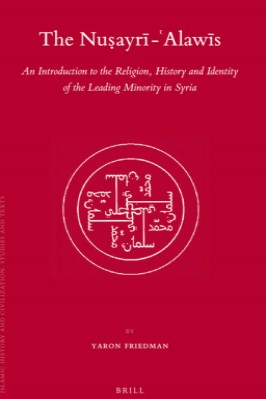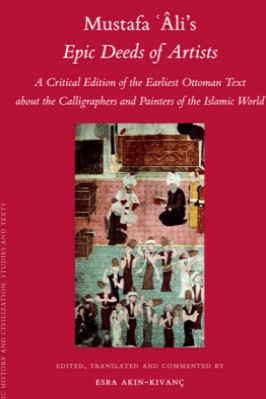The Nuşayrī-‘Alawīs – An Introduction to the Religion, History and Identity of the Leading Minority in Syria (Islamic History and Civilization)

| The Nushayri Alawis |
| Yaron Friedman |
| 351 |
| |
| PDF Direct Link |
| Click for Copy from Amazon |
THE NUSHAYRI ALAWIS – Book Sample
PREFACE – THE NUSHAYRI ALAWIS
This monograph offers research on the Nuṣayrī-ʿAlawīs , covering a variety of aspects. The absence of such research since Dussaud ’s Histoire et religion des Nosairīs (1900) demands a new comprehensive study.
The aim of this book is to review the history and religion of the sect in the light of old documents used by orientalists in the nineteenth century, documents that became available in the twentieth century, and later sources of the Nuṣayrī-ʿAlawī sect published most recently in Lebanon .
Another goal here, not dealt with in Dussaud’s book, is to study the question of the identity of the sect through the ʿAlawī-Sunnī-Shīʿī triangle.
A consistent endeavor has been made to keep the research for this book as objective as possible. Notwithstanding the claim of objectivity by Western scholars, they have a tendency to repeat the orthodox Sunnī point of view concerning the identity of sects.1
Western publications tend to refer to the Nuṣayrī-ʿAlawīs as heretics, although the members of the sect consider themselves to be Muslims. The use of the term “sect” is neither pejorative nor in opposition to “the church”, as suggested by Max Weber.2 Many criticisms have been raised against its use as a translation of the Arabic firqa (pl. firaq).
Marshall Hodgson, for example, explains that Weber’s definition is based on his study of the Christian church, which differs from Islamic orthodoxy in many ways.3
Michael Cook holds that Weber’s explanation that the sect is non-political and non-hierarchic is wrong when applied to Muslim sects and Shīʿī groups in particular.4 Although these criticisms are valid, Cook and Hodgson do not propose an alternative translation for the term firqa.
Hence, our consideration of the Nuṣayrī-ʿAlawīs as a sect follows Heinz Halm ’s view that Weber’s definition or parts of it could be appropriate for such sects as the Druzes but not for the Shīʿa: “a small number of adherents, lack of state recognition, spontaneous confession and freedom to join or not join, members’ awareness that they belong to a religious separate qualified elite”.5 In my opinion, this selective definition also fits the Nuṣayrī sect.
In Arabic, the word firqa usually has a negative connotation, while ṭāʾifa is used in a positive sense , but not necessarily in every case.
Since the sacred writings of the Nuṣayrī-ʿAlawīs are kept secret by the members of the sect because of their sensitivity, it is important to note that the religious material used in this volume is only that which is accessible in public libraries and printed books.
My research did not involve private sources and libraries, or personal manuscripts belonging to members of the sect. Moreover, I believe that a true understanding of the available material is limited to the external level that a non-ʿAlawī can reach. A profound grasp of these writings can be achieved only by the sect’s mystical shaykhs.
I owe a special dept of gratitude to Professor Kais Firro of the University of Haifa, who backed this project and made valuable suggestions. I wish to thank my friend and colleague, Dr. David Cook, without whom the newest and the most important sources for this study would not have been accsessible.
He contributed to the improvement of my previous research, by reading early drafts of my two articles and adding important notes. I also owe a special debt to Mrs. Rebecca Toueg and to Margaret Owen for their rigorous editing of the manuscript.
The present work is a result of a research process that began in 1995 at the Hebrew University of Jerusalem .
I was first introduced to the Nuṣayrī-ʿAlawī doctrine and history by Dr. Meʾir M. Bar-Asher , an authority in the field. During these studies, I initiated my first original research in the field, focusing on al-Khaṣībī , the actual founder of the sect and a key figure for the understanding of the sect’s identity.
This research yielded an article6 that is used in this book with some additions and improvements. The enlargement of the research into a study of the Nuṣayrī-ʿAlawī identity between Sunna and Shīʿa, including medieval and modern aspects, was enabled thanks to a doctoral scholarship granted by the French government in 2001–2003 at the Sorbonne Paris IV University.
I was guided with devotion by Professor Paul Fenton , an expert on Jewish and Islamic mysticism, whose vast knowledge contributed to its completion. This study, entitled Les Nuṣayrī-ʿAlawīs entre Sunna et Shīʾa: refus et acceptation selon les sources arabes médiévales et modernes,7 was completed in 2006. It was approved (très honorable) by the jury, which was headed by Professor Muhammad Ali Amir-Moezzi and consisted of Professor Fenton, Professor Burhan Ghalioun and Dr. Stéphane Valter.8 Professor Moshe Maoz and Professor Eyal Zisser, experts in Syrian politics, were external judges of the thesis. With numerous additions and some corrections, the thesis served as a basis for several parts of this book.
I wish to thank all the above-mentioned scholars for their support and encouragement of my research. Most of their important notes concerning my doctorate were considered carefully in the actual research. The book includes another recent article on the most famous Sunni decree concerning the Nuṣayrī-ʿAlawī sect.9
To read more about the The Nushayri Alawis book Click the download button below to get it for free
Report broken link
Support this Website

 Don't Miss out any Book Click Join OpenMaktaba Telegram group
Don't Miss out any Book Click Join OpenMaktaba Telegram group